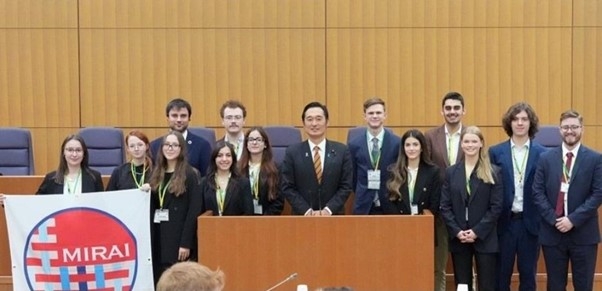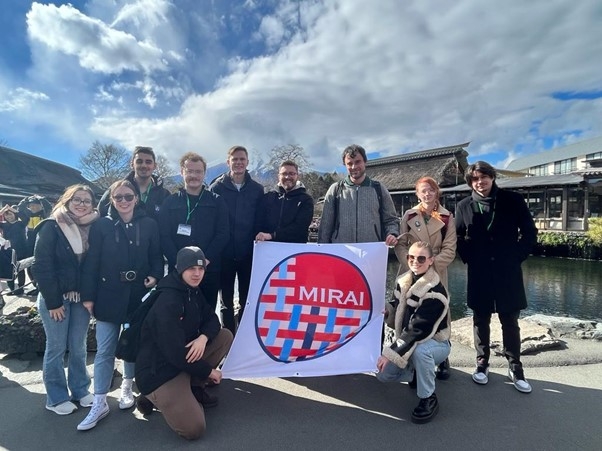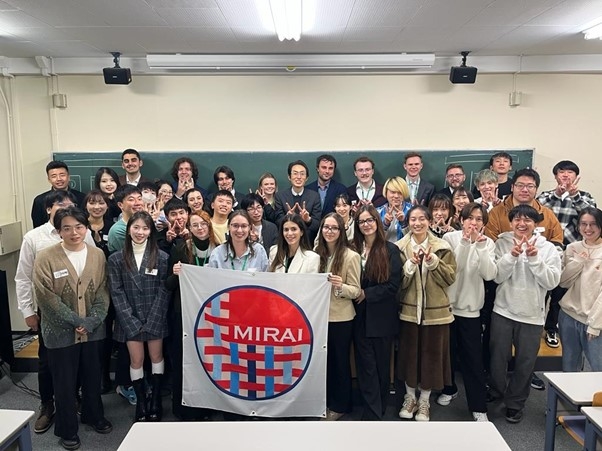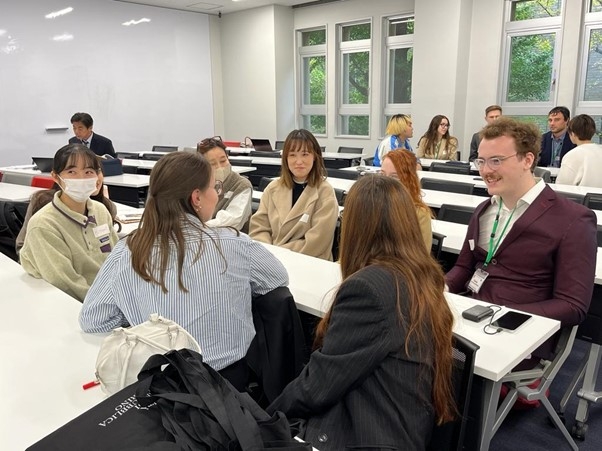Culture & Education
2025/11/13
MIRAI Programme - Ciarán Maher


My name is Ciarán Maher and I’m a 4th year zoology student at UCD. Without doubt, the highlight of my time at university so far was having the honour of taking part in the 2023/24 MIRAI Programme. I was one of a few students from across Europe, Central Asia, and the Caucasus who had the opportunity to travel to Japan thanks to this incredible initiative funded by the Japanese Ministry of Foreign Affairs (MOFA).
Along with 14 other students from countries stretching from Iceland to Malta, I was placed in Group 5, “The Environment and the Green.” This meant that much of our schedule focused on Japan’s efforts in sustainability and environmental protection. We toured the Euglena energy facility, where researchers have developed a way to use a small alga as a clean source of reusable bio-jet diesel fuel. We also spoke with leaders at NEDO (New Energy and Industrial Technology Development Organization), a government-affiliated agency promoting hydrogen energy as part of Japan’s path towards carbon neutrality. They explained how Japan shifted away from nuclear power after the 2011 Fukushima disaster and is now leading the way in hydrogen energy. Learning about these innovations showed me how Japan continues to adapt and remain at the forefront of clean energy development.
Just as memorable for me was the chance to experience how deeply nature is valued in Japanese culture. Zojoji and Asakusa temples serve as little oases of natural scenery among the urban sprawl of Tokyo. On the way to Oshino Hakkai, we visited the Sengen Shrine where we learned about Shintoism, the native religion of Japan that honours spirits and nature. From there, we took in breathtaking views of Mount Fuji, reflected in the clear ponds of Oshino Hakkai. Later, at the Mount Fuji World Heritage Centre, we learned about the mountain’s cultural and spiritual importance. It is sacred in both Shintoism and Buddhism, while also standing as a national symbol of resilience and harmony with nature. Seeing Mt Fuji in this context was truly unforgettable, and it is easy to see why Mt Fuji has inspired much of Japan’s most celebrated artwork.
The programme also introduced us to other aspects of Japanese history and culture. At the Edo Museum, we gained a glimpse into daily life in Japan during the Edo period, while the Tokyo National Museum amazed me with its vast collection of artifacts, including nearly 90 National Treasures. One of the most culturally enriching experiences, however, was taking part in a traditional tea ceremony led by a tea master from the Urasenke tea school. The calm, mindful atmosphere and the precision of each movement really made me feel connected to Japanese tradition.
A huge part of what made MIRAI so special for me was the people. My fellow participants were intelligent, kind, and full of energy, and it was a privilege to spend the week with them. The Japanese people we met were equally warm and generous. From strangers who helped us navigate public transport to hotel staff and guides who went out of their way to make us feel comfortable, their kindness left a lasting impression on me. Our translator, Ako-san, deserves special mention. She was always upbeat and ensured we had the best possible experience. Even meeting the Deputy Minister of Foreign Affairs felt personal and welcoming, as he genuinely listened to what we had to say.
MIRAI was truly a once-in-a-lifetime experience, and I will always be grateful to have been part of it. It deepened my appreciation for Japanese culture, inspired me to stay connected with Japan, and has encouraged me to apply for the JET Programme next year. For anyone who dreams of visiting Japan or has an interest in its culture, I couldn’t recommend MIRAI highly enough.
Along with 14 other students from countries stretching from Iceland to Malta, I was placed in Group 5, “The Environment and the Green.” This meant that much of our schedule focused on Japan’s efforts in sustainability and environmental protection. We toured the Euglena energy facility, where researchers have developed a way to use a small alga as a clean source of reusable bio-jet diesel fuel. We also spoke with leaders at NEDO (New Energy and Industrial Technology Development Organization), a government-affiliated agency promoting hydrogen energy as part of Japan’s path towards carbon neutrality. They explained how Japan shifted away from nuclear power after the 2011 Fukushima disaster and is now leading the way in hydrogen energy. Learning about these innovations showed me how Japan continues to adapt and remain at the forefront of clean energy development.
Just as memorable for me was the chance to experience how deeply nature is valued in Japanese culture. Zojoji and Asakusa temples serve as little oases of natural scenery among the urban sprawl of Tokyo. On the way to Oshino Hakkai, we visited the Sengen Shrine where we learned about Shintoism, the native religion of Japan that honours spirits and nature. From there, we took in breathtaking views of Mount Fuji, reflected in the clear ponds of Oshino Hakkai. Later, at the Mount Fuji World Heritage Centre, we learned about the mountain’s cultural and spiritual importance. It is sacred in both Shintoism and Buddhism, while also standing as a national symbol of resilience and harmony with nature. Seeing Mt Fuji in this context was truly unforgettable, and it is easy to see why Mt Fuji has inspired much of Japan’s most celebrated artwork.
The programme also introduced us to other aspects of Japanese history and culture. At the Edo Museum, we gained a glimpse into daily life in Japan during the Edo period, while the Tokyo National Museum amazed me with its vast collection of artifacts, including nearly 90 National Treasures. One of the most culturally enriching experiences, however, was taking part in a traditional tea ceremony led by a tea master from the Urasenke tea school. The calm, mindful atmosphere and the precision of each movement really made me feel connected to Japanese tradition.
A huge part of what made MIRAI so special for me was the people. My fellow participants were intelligent, kind, and full of energy, and it was a privilege to spend the week with them. The Japanese people we met were equally warm and generous. From strangers who helped us navigate public transport to hotel staff and guides who went out of their way to make us feel comfortable, their kindness left a lasting impression on me. Our translator, Ako-san, deserves special mention. She was always upbeat and ensured we had the best possible experience. Even meeting the Deputy Minister of Foreign Affairs felt personal and welcoming, as he genuinely listened to what we had to say.
MIRAI was truly a once-in-a-lifetime experience, and I will always be grateful to have been part of it. It deepened my appreciation for Japanese culture, inspired me to stay connected with Japan, and has encouraged me to apply for the JET Programme next year. For anyone who dreams of visiting Japan or has an interest in its culture, I couldn’t recommend MIRAI highly enough.


